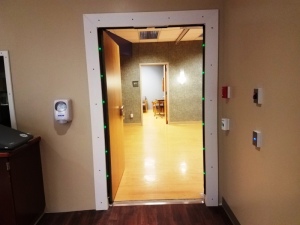by
John R. Fischer, Senior Reporter | October 09, 2017

Cleaning doorways to MR rooms is
important for preserving shield life as over
time dirt and materials build up along the
frame of the door, interfering with the
shields ability to block radiofrequency waves
For all the interesting gadgetry involved in MR imaging, it’s easy to forget there is a vital element hiding behind the scenes that makes it all possible – the radiofrequency shield.
In fact, it’s not unusual for this essential component to receive little or no attention on a day-to-day basis from the end users who operate from within it.
Neglecting a shield increases the likelihood of radiofrequency waves leaking into the room, distorting images and adding delays to potentially urgent patient diagnoses and treatment.



Ad Statistics
Times Displayed: 174476
Times Visited: 3183 For those who need to move fast and expand clinical capabilities -- and would love new equipment -- the uCT 550 Advance offers a new fully configured 80-slice CT in up to 2 weeks with routine maintenance and parts and Software Upgrades for Life™ included.
And it isn’t only individual patients who suffer from a compromised MR shield. Providers can expect hefty fees to repair shields, or in some cases, be faced with purchasing a completely new one if the damage is too extensive.
So what does it take to prevent radiofrequency waves from sneaking in and holding your facility hostage?
Although no shield lasts forever, getting smart about installing and maintaining your shield can increase its longevity and ensure deterioration is detected early – before it becomes a bigger problem.
Selecting the right materials
When choosing a shield, different metals will offer different strengths, a major factor in the life expectancy of a shield. The three most common materials used to construct shields are copper, aluminum and galvanized steel.
“There is little argument that copper is superior because of its conductivity factors and long-term reliability … the other two types of material, aluminum and steel would have less of a warranty from a shield integrity perspective,” Mike Krachon, director at IMEDCO, told HealthCare Business News. “That is why just about every supplier would recommend copper if it can be afforded. It is the most expensive solution but it is also often the preferred approach.”
Shield manufacturers recommend copper as it is more conductible than aluminum and galvanized steel, possessing a greater ability to resist the flow of radiofrequency waves. It also can withstand elements, such as water, more efficiently and is warranted with life expectancy rates starting at 10 years or more whereas galvanized steel expectancy rates are typically around five years. Welded aluminum can last for around ten years but the majority of vendors use paneled aluminum which has a life expectancy rate typically of three to five years.
Still, these alternative materials sometimes offer more than just a budget-friendly price tag. For example, aluminum is recommended as a better option for resisting certain types of interference.


Marshall Shannon
re: MR shielding: out of sight, but hopefully not out of mind
October 10, 2017 09:13
FACT
to rate and post a comment